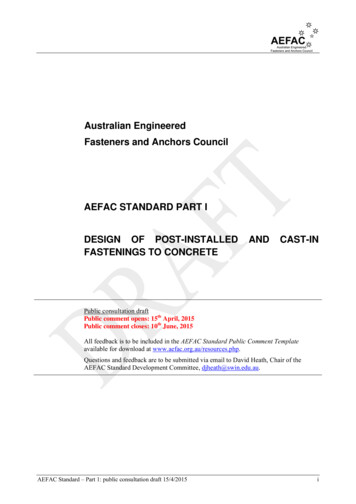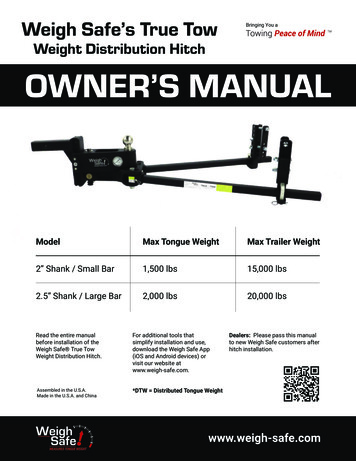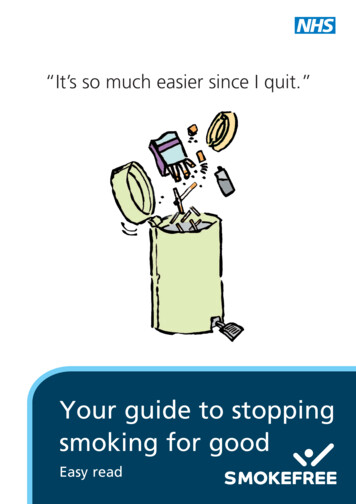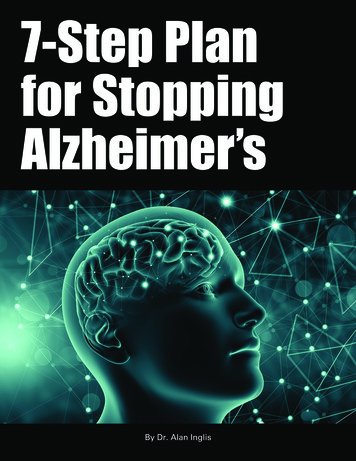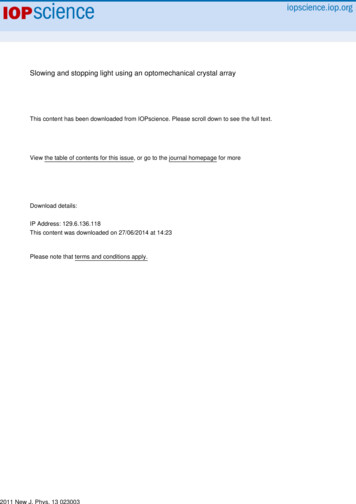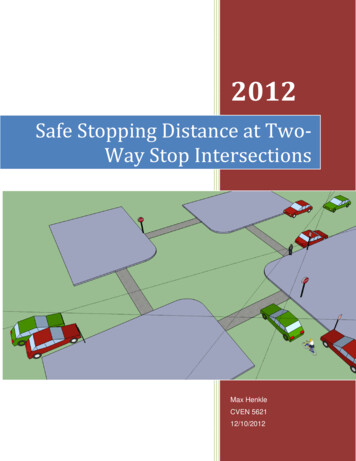
Transcription
2012Safe Stopping Distance at TwoWay Stop IntersectionsMax HenkleCVEN 562112/10/2012
Max HenkleSafe Stopping Distance at Two-Way Stop IntersectionsCVEN 5621ContentsAbstract . 2Introduction . 2Study Area Characteristics . 3Warrants . 5Sight Triangles . 6Departure Sight Triangles . 8Methods . 12Study Site . 12Intersection Sight Distance . 14Safe Stopping Distance . 15Major Street Passenger Car Stopping Time . 15Passenger Car Clearance Time. 16Bicycle Clearance Time . 16Pedestrian Clearance Time . 17Results and Discussion . 18Minor Street Passenger Car Clearance . 18Minor Street Bicycle Clearance. 19Minor Street Pedestrian Clearance . 19Issues with Assumptions . 20Reccomendations . 21Conclusion . 23Bibliography . 241
Max HenkleSafe Stopping Distance at Two-Way Stop IntersectionsCVEN 5621AbstractAccording to the Uniform Vehicle Code via Figure 3B-21 of the MUTCD, a 20ft NoParking zone, as measured from the end parking space to the crosswalk, is required. Isthis number appropriate in all circumstances? In situations where two-way stops andnarrow streets exist, effective sight distance can be obscured by vehicles parked on thestreet. Therefore, it can difficult for vehicles, bicycles, and pedestrians stopped behindintersection thresholds with non-yielding cross-traffic to determine when the intersectioncan safely be cleared. A case study was made at the intersection of 5th Avenue andPennsylvania Street in the City and County of Denver, CO. This is a two-way stopcontrolled intersection of two narrow, local streets with on-street parking. Usinggeometric lines of sight and intersection clearance time calculations outlined in theHighway Capacity Manual and AASHTO Green Book, sight triangles were created inorder to determine (1) at what point cross-traffic becomes visible to the user behind thestop bar, (2) the available clearance time, and (3) whether 25mph is an acceptably safespeed for cross-traffic. Recommendations were made regarding safe speed andexpansion of the No-Parking zones in order to enhance stopping sight distances.Greater elaboration of the role of on-street parking on sight triangles in the Green Bookwas desired.Data on intersection width and no-parking zones was gathered principally through photointerpretation, with supplemental field measurements. Intersection type and speed limitswere determined though data provided by the City and County of Denver GISdepartment. The HCM and AASHTO Green Book was used to determine auto andpedestrian clearance time, while bicycle clearance time was determined empirically.IntroductionTwo-way stop controlled intersections with unmarked crosswalks are commonlyencountered in residential neighborhoods. At a two-way stop controlled intersection,traffic on the “minor” street is required to stop behind the crosswalk and yield to trafficon the cross (“major”) street before proceeding. Yet when on-street parking is presenton narrow streets, users’ ability to recognize conflicting traffic can be impaired. The2
Max HenkleSafe Stopping Distance at Two-Way Stop IntersectionsCVEN 5621HCM and Green Book make little mention of local street design, devoting the majority oftheir attention to roadways of higher volume and capacity.It is entirely possible, however, that the design of local streets can play an important rolein the safety of the overall transportation network. In a study of 24 California citiesbetween 30,000 and 150,000 in population, Marshall and Garrick found that older citiesand those with higher nodal intersection density to be significantly safer than thosewhich incorporated later with a more curvilinear and hierarchical form (Street NetworkTypes and Road Safety: A Study of 24 California Cities, 2010). In comparingintersection density, cities in the safer group experienced 40.6% fewer serious crasheswith average intersection density of 106 per square mile, versus 63 per square mile forthe less safe group. Cities in the safer group also had a significantly earlier date ofincorporation (1895 vs. 1932) and experienced 73.2% fewer non-highway fatalities.Study Area CharacteristicsThe central core of the Denver, Colorado (incorporated in 1861) is comprised of anumber of residential neighborhoods which developed prior to the widespread adoptionof automobile usage. The prevailing form of intermediate distance passenger transportprior to the auto era via the streetcar, with the “last mile” leg of the trip accomplished onfoot. Therefore, residentialneighborhoods developed during theera of the streetcar tended to have highnodal connectivity, sidewalks, andnarrow streets. Today, many streets ofthe Capitol Hill/Alamo Placitaneighborhood of the City and County ofDenver have retained these originalcharacteristics. Most streets with a localclassification are 30-40 feet wide andallow for on-street parking on both sidesof the street and unmarked crosswalksFigure 1: Regional Overview (Google Maps)3
Max HenkleSafe Stopping Distance at Two-Way Stop IntersectionsCVEN 5621(City and County of Denver GIS Department). Sidewalks for these streets are detached.The unmarked speed limit for local street in the City and County of Denver is 25 milesper hour (City and County of Denver GIS).Most street centerlines are spaced 325feet in the east-west direction and 600feet in the north-south direction. Thestudy area has 154 intersections persquare mile. In part due to this tightintersection spacing, many of theintersections within this neighborhoodare controlled by two-way stopintersections.The question: Is 25 miles per hour anappropriate speed for the approaches tothese two-way stop controlledintersections for passenger cars,bicycles, and pedestrians? Furthermore,do the Highway Capacity Manual(HCM), AASHTO “Green Book”, andManual on Uniform Traffic ControlDevices (MUTCD) adequately addressFigure 2: Study Area (C&C of Denver GIS)this issue? Could safety be improved byincreasing no-parking buffers on the major street approaches to the intersection?4
Max HenkleSafe Stopping Distance at Two-Way Stop IntersectionsCVEN 5621WarrantsSection 2B.06 of the (MUTCD) warrants the following conditions for the placement oftwo-way stop controlled intersections:The use of STOP signs on the minor-street approaches should beconsidered if engineering judgment indicates that a stop is alwaysrequired because of one or more of the following conditions:A. The vehicular traffic volumes on the through street or highway exceed6,000 vehicles per day;B. A restricted view exists that requires road users to stop in order toadequately observe conflicting traffic (emphasis added) on the throughstreet or highway; and/orC. Crash records indicate that three or more crashes that are susceptibleto correction by theinstallation of a STOPsign have beenreported within a 12month period, or thatfive or more suchcrashes have beenreported within a 2year period. Suchcrashes include rightangle collisionsinvolving road userson the minor-streetapproach failing toyield the right-of-wayto traffic on thethrough street orhighway. (US FederalHighwayAdministration, 2009)The MUTCD goes on tostate via UVC1 Sections 1Figure 3: MUTCD No-Parking Zone Requirements1The “Uniform Vehicle Code” (see Section 1A.11) has the following provision in Section 15-104 for the adoption ofa uniform manual: 2009 Edition Page 3 December 2009 Sect. 1A.07 to 1A.08“(a) The [State Highway Agency] shall adopt a manual and specification for a uniform system of traffic controldevices consistent with the provisions of this code for use upon highways within this State. Such uniform systemshall correlate with and so far as possible conform to the system set forth in the most recent edition of the Manual5
Max HenkleSafe Stopping Distance at Two-Way Stop IntersectionsCVEN 5621118 and 11-1003 that a 20 foot buffer needs to be employed between the threshold ofan unmarked crosswalk on the first and last on-street parking spaces, presumably inorder to improve the ability to observe conflicting traffic.Sight TrianglesThe AASHTO Green Book defines a sight triangle as “Specified areas along intersectionapproach legs and across their included corners [that] should be clear of obstructionsthat might block the driver’s view of potentially conflicting vehicles (p.652)”. According toAASHTO, the dimensions of sight triangles are determined by observed driver behaviorand documented by space time profiles and speed choices of drivers on intersectionapproaches. The Green Book differentiates between approach sight triangles (used indetermining whether some form of intersection control is warranted) and departure sighttriangles. Departure sight triangles are defined as a “sight triangle [that] provides sightdistance sufficient for a stopped driver on a minor-road approach to depart from theFigure 4: Sight Triangles (Harwood et al)on Uniform Traffic Control Devices for Streets and Highways, and other standards issued or endorsed by theFederal Highway Administrator.”“(b) The Manual adopted pursuant to subsection (a) shall have the force and effect of law.”All States have officially adopted the National MUTCD either in its entirety, with supplemental provisions, or as aseparate published document.”6
Max HenkleSafe Stopping Distance at Two-Way Stop IntersectionsCVEN 5621intersection and enter or cross the major road. The Green Book states that “departuresight triangles should be provided in each quadrant of each intersection approachcontrolled by a stop or yield sign (p. 653)”.Harwood et al, using video detection, recommended 7.5s of travel time at the designspeed of the major road (Design policies for sight distance at stop-controlledintersections based on gap acceptance, 1999). Left turns were determined to requirethe greatest gap acceptance time.AASHTO recommends this sight triangles be calculated considering both the horizontaland vertical dimension of the obstruction, and at a drivers’ eye height and object seenheight of 3.5 ft. above the roadway surface. The object height is based on a vehicleheight of 4.35, representing the 15th percentile height of passenger cars as they existedin 2004.The Green Book outline recommended sight triangles based on intersection controltype. For two-way stop controlled intersections, Case B applies, with three subcasesrepresenting the three possible movements of the user on the minor approach. Thesedistances may be adjusted for grade using Exhibit 9-53 of the Green Book, though forgrades between -3.0% and 3.0% the grade remains static.What is clear from Figure 4 is that if the distance of an actual site triangle’s major streetleg (in this case d1 and d2) is less than the minimum distance required for the driver onthe major to recognize and obstacle and come to a complete stop, collisions are morelikely to occur.The Denver Streetscape Design Manual is very prescriptive on the role of vegetation onsightlines (including a 20 foot minimum corner triangle clear zone outlined byAASSHTO); however, its realm is limited to obstructions lying within the curb line. Onstreet parking is not referenced (City and County of Denver, 1993)7
Max HenkleSafe Stopping Distance at Two-Way Stop IntersectionsCVEN 5621Figure 5: Landscaping - Sight Triangles (Denver Streetscape Design Manual)Departure Sight TrianglesThe Green Book expands on the concept of sight triangles by differentiating betweenapproach sight triangles (used in the analysis of uncontrolled intersections) withdeparture sight triangles, which accurately describe the situation in our case study of astopped vehicle determining the suitable of entering an intersection. Chapter Nine Intersections outlines the following procedures for determining departure sight trianglesin its Cases B1-3:8
Max HenkleSafe Stopping Distance at Two-Way Stop IntersectionsCVEN 5621Departure sight triangles for traffic approaching from either the left or theright like those shown in Exhibit 9-50B should be provided for left turnsfrom the minor road onto the major road for all stop-controlledapproaches.The vertex (decision point) of the departure sight triangle on the minorroad should be 4.4m [14.5 ft] from the edge of the major-road traveledway. This represents the typical position from the minor-road driver’s eyewhen a vehicle is stopped relatively close to the major road. Fieldobservations of vehicle stopping positions found that, where necessary,drivers will stop with the front of their vehicle 2.0 m [6.5 ft] or less from theedge of the major-road traveled way. Measurements of passenger carsindicate that the distance from the front of the vehicle to the driver’s eyefor the current passenger car population is nearly always 2.4 m [8 ft] orless. Where practical, it is desirable to increase the distance from the edgeof the major-road traveled way to the vertex of the clear sight triangle from4.4 m to 5.4 m [14.5 to 18 ft]. This increase allows 3.0 m [10 ft] from theedge of the major-road traveled way to the front of the stopped vehicle,providing a larger (emphasis added) sight triangle. The length of the sighttriangle along the major road (distance a in Exhibit 9-50B) is the sum ofthe distance from the major road plus ½ lane width for vehiclesapproaching from the left, or 1-½ lane width for vehicles approaching fromthe right (p657-660).Similarlanguage isuse todescribethrough andright turns(Case B2and B3,respectively)Figure 6: Exhibit 9-50B (AASHTO Green Book). Threepoints are notable: first, the Green Book recommends the stopping point be further fromthe intersection, requiring a larger decision sight triangle. Second, left turns require thelargest sight triangles (and therefore stopping distances). Figures 7 and 8 and Table 19
Max HenkleSafe Stopping Distance at Two-Way Stop IntersectionsCVEN 5621and 2 outline these differences for a two-lane highway, with no median, a grade within /- 3 %, and (presumably) no on-street parking. Third, little mention is made of theunique challenges that on-street parking imposes on sight triangles.Table 1: Exhibit 9-55 Design Intersection Sight Distance - Case B1 - Left Turn From a Stop - G /- 3%, TwoLane Highway, No Median (Green Book)10
Max HenkleSafe Stopping Distance at Two-Way Stop IntersectionsCVEN 5621Figure 7: Exhibit 9-56 Intersection Sight Distance - Case B1 - Left Turn from a Stop (Green Book)Table 2: Exhibit 9-57 Design Intersection Sight Distance - Case B2 - Right Turn From a Stop and Case B3 Crossing Maneuver G /- 3% Two-Lane Highway, No Median (Green Book)11
Max HenkleSafe Stopping Distance at Two-Way Stop IntersectionsCVEN 5621Figure 8: Exhibit 9-59 Intersection Sight Distance - Case B2 - Right Turn from a Stop and Case B3 CrossingManeuver (Green Book)MethodsIn order to determine whether 25 miles per hour is an appropriate speed for the studyarea’s narrow local streets, a representative study intersection was chosen. Then, usingGIS, decision sight distances were calculated for passenger cars, bicycles, andpedestrians on the minor approach and compared to the safe stopping distances andtimes for passenger cars on the major approach. In the interest of simplifyingcalculations, only crossing maneuvers on the minor approach were analyzed.Study SiteThe site chosen for analysis was the intersection of 5th Avenue and Pennsylvania Streetin the City and County of Denver, Colorado. This intersection is characterized by thefollowing qualities: Width of both streets is 30 ft The speed limits of both street is unsigned and therefore 25 mi/h12
Max HenkleSafe Stopping Distance at Two-Way Stop Intersections On-street parking exists on both sides of both streets Pennsylvania is stop-controlled (minor street) 5th Ave is not stop-controlled (major street) No-Parking zone distances from unmarked crosswalks varyCVEN 5621Figure 9 outlines the layout of this intersection:Figure 9: Street Geometry: 5th Ave and Pennsylvania StNotably, the stop sign placement and No-Parking clear zones comply with MUTCDstandards of 20 ft minimum. No-Parking zones on the major street, however, are morevariable, ranging from a low of 10 ft to a high of 20 ft. Parked automobiles on the majorstreet represent a significant obstacle, which will be illustrated in the Results andDiscussion. Because the sight lines of the southbound approach are the most restricted,13
Max HenkleSafe Stopping Distance at Two-Way Stop IntersectionsCVEN 5621only sight triangles viewed from the southbound approach are used in the followingcalculations.Intersection Sight DistanceOn pages 650-651, the Green Book states,Sight distance is provided at intersections to allow the drivers to perceivethe presence of potentially conflicting vehicles. This should occur insufficient time for motorists to stop or adjust their speed, as appropriate, toavoid colliding in the intersection. The methods needed for determiningsight distance are the same for determining stopping sight distance, butincorporate modified assumptions. Based on observed driver behavior atintersections .Sight Distance is also provided at intersections to allow thedrivers of stopped vehicles a sufficient view of the intersecting highway todecide when to enter the intersecting highway or when to cross it. If theavailable sight distance for an entering roadway is at least (emphasisadded) equal to the stopping sight distance for the major road, the drivershave sufficient sight distance to anticipate and avoid collisions.The Green Book determines “Intersection Sight Distance” using Formula 9-1. That is,ISD 1.47 Vmajor tgWhere ISD Intersection Sight Distance (length of the leg from the sight triangle alongthe major road (ft)Vmajor design speed of road (mi/h)tg time gap for minor road vehicle to enter major roadTime gaps for passenger cars are determined to be 7.5 s for a stopped vehicle makinga left turn onto a two-lane highway with no median and a grade of three percent or less.Using these metrics on a 25 mi/h road we find that ISD 275.6 ft.14
Max HenkleSafe Stopping Distance at Two-Way Stop IntersectionsCVEN 5621Safe Stopping DistanceMeanwhile, Garber and Hoel use a slightly different method to calculate safe stoppingdistance. According to Equation 3.27 safe stopping distance (SSD) is determined as,ds 1.47(Sit Si2/(30*(0.348 /-0.01G))) where ds Safe Stopping Distance (ft) Si Initial speed of vehicle, mi/h G Grade (%) t reaction time of 2.5sUsing Garber and Hoel calculation method and assuming grade to be level, we find atypical driver would need 151 ft to safely stop from 25 mi/h.Major Street Passenger Car Stopping TimeThe time required for the driver of a passenger car to recognize an obstacle and braketo a stop is calculated according the following method. AASHTO Stopping Sight Distance based on average deceleration rate (a d) of11.2 ft/sec2 per NUTCD (Acceleration Characteristics of Starting Vehicles,2000) tstop vo/ ad (assuming G 0) vo 25 mi/h 36.7 ft/s Example: tstop (36.7 ft/s)/(11.2 ft/sec2) 3.3 sWhen reaction time (assumed at 2.5 s) is accounted for, total stop time istTotalStop tstop treaction 3.3 s 2.5 s 5.8 s15
Max HenkleSafe Stopping Distance at Two-Way Stop IntersectionsCVEN 5621Passenger Car Clearance TimeIn order to calculate passenger car clearance time of the minor street, we deviate fromtypical engineering manuals and instead use a calculus-derived distance equation.Assuming grade to be level and an accelerating vehicle reaction time of 0s, thendc vot 0.5at2 where dc clearance distance crossing distance length of passenger car (L),taken from the Green Book to be 19 ft. a average acceleration 4.72 ft/s2 from 0-25 mi/h derived from the Green Book(Acceleration Characteristics of Starting Vehicles, 2000) vo 0 mi/hTherefore, tclearance (d ft/4.72 ft/s2)0.5For example, if dc 45ft, then tclearance (45ft/4.72 ft/s2)0.5 3.1sNote that when on-street parking is present, the crossing distance for all modes isreduced by 7 ft, the width of a passenger car design vehicle (local residential streets).Bicycle Clearance TimeLittle data was available to calculate bicycle acceleration rates. Therefore clearancetime data was obtained empirically. Ten runs were performed in which a bicycleaccelerated from a full stop at the stop-sign of the minor road of the study site(Pennsylvania St) and traveled past the point at which the rear wheel of the bicyclecleared the farthest travel lane on the major street (5th Ave).This distance wasmeasured to be 49 ft. The 15th percentile slowest run was then used as therepresentative bicycle clearance time, yielding 6.1 s.16
Max HenkleSafe Stopping Distance at Two-Way Stop IntersectionsCVEN 5621Table 3: Empirical Bicycle Acceleration Data, Stop Line to Full Clearance (5th Ave and Pennslvaniam St)Pedestrian Clearance TimePedestrian clearance times were calculated using the HCM formula for minimumpedestrian green time when sidewalk width is less than or equal to 10 ft:,Gp 3.2(0.27*Nped) (L/Sp)Where: Gp minimum pedestrian crossing time (s) L length of crosswalk (ft.) Sp ave. walking speed of pedestrians (3.5 ft/s) Nped number of pedestrians per phase in a single crosswalkFor example, if L 30ft Nped 1Then Gp (3.2 s)*(0.27*1) (23 ft/3.5 ft/s) 7.4 s17
Max HenkleSafe Stopping Distance at Two-Way Stop IntersectionsCVEN 5621Results and DiscussionBased on the previously outlined methods, clearance and safe stopping times wereobtained for the representative intersection of 5th Ave and Pennsylvania St.Minor Street Passenger Car ClearanceBased on sight triangles created in GIS, it was calculated that a passenger car on theminor approach would need a maximum of 3.7s and travel a maximum of 63 ft to clearthis intersection. Meanwhile the decision sight distance (based on the HCM prodedureof placing the driver’s eyes 8 ft behind the edge of the unmarked crosswalk) for themajor street cross flow is 58 ft from the driver’s right side and 79 ft from the driver’s leftside. Both 58 ft and 79 ft can be traveled in less time than the 2.5 s major street driverreaction time assuming a constant 25 mi/h (36.7 ft/s). The safe stopping distance at 25mi/h is 151 ft and 5.8 seconds. Therefore, both of the actual sight triangles for thesouthbound approach imply that this intersection is unsafe given the existing speedlimits and parking arrangment.Figure 10: Passenger Car Clearance Distances and Times (5th Ave and Pennsylvania St)18
Max HenkleSafe Stopping Distance at Two-Way Stop IntersectionsCVEN 5621Minor Street Bicycle ClearanceBased on sight triangles created in GIS, it was calculated that a bicyle on the minorapproach would need a maximum of 6.1 s and travel a maximum of 49 ft to clear thisintersection. It was assumed the that the cyclist’s are 2 ft from the edge of the unmarkedcrosswalk. Meanwhile the decision sight distance for the major street cross flow is 61 ftfrom the cyclist’s right and left sides. 61 ft can be traveled in less time than the 2.5 smajor street driver reaction time assuming a constant 25 mi/h. The safe stoppingdistance at 25 mi/h is 151 ft and 5.8 seconds. Therefore, both of the actual sighttriangles for the southbound approach imply that this intersection is unsafe given theexisting speed limits and parking arrangment.Figure 11: Bicycle Clearance Distances and Times (5th Ave and Pennsylvania St)Minor Street Pedestrian ClearanceUnlike the passenger car and bicyle examples, a pedestrian crosses from a differentlocation. This leads to a shorter crossing distance, somewhat offsetting the realtivielyslower traveling speed. Based on sight triangles created in GIS, it was calculated that apedestrian on the minor approach would need a approximately 7.4 s and travel amaximum of 23 ft to clear this intersection. It was assumed the pedestrian commits to19
Max HenkleSafe Stopping Distance at Two-Way Stop IntersectionsCVEN 5621the crossing at the southern edge of the western sidewalk. The decision sight distancefor the major street cross flow is 62 ft from the cyclist’s right side and more than 180 ftfrom the pedestrian’s left side. 62 ft can be traveled in less time than the 2.5 s majorstreet driver reaction time assuming a constant 25 mi/h. The safe stopping distance at25 mi/h is 151 ft and 5.8 seconds. Therefore, the right (western) sight triangle for thesouthbound approach implies that this intersection is unsafe given the existing speedlimits and parking arrangment. Since the decision sight distance for the left (eastern)approach exceeds 151 ft, safe stopping distance is achieved.Figure 12: Pedestrian Clearance Distances and Times (5th Ave and Pennsylvania St)Issues with AssumptionsIf in fact this intersection is “unsafe” based on the analysis of the sight triangles, whythen are there not accidents at locations such as this on a daily basis? The followingphenomena could be contributing to accident avoidance:1. Narrow lanes are demonstrated to reduce speeds. Mitigation Strategies forDesign Exceptions published the following table on this relationship (US Federal20
Max HenkleSafe Stopping Distance at Two-Way Stop IntersectionsCVEN 5621Highway Administration, 2007). While the data below pertains to freeway lanesand therefore speeds), it is reasonable to believe that some of this effect remainsat the lower speeds encountered on local streets.Lane width (ft)121110Reduction in Free-FlowSpeed (mi/h)0.01.96.6Table 4: Operational Effects of Freeway Lanes Widths2. On-street parking reduces by increasing “friction”. In a study of 250 Connecticutroadways, free-flow speeds on streets with on-street parking were found to be2.3 mi/h less than those without on-street parking. Speed reduction werecompounded when other street design factors, such as shorter building setbacksand road vs. street typology were considered (Reassessing On-Street Parking,2008).3. Road users, cognizant of the limited sight distances, exercise greater caution onintersection approaches.4. Based on points 1,2, and 3, free-flow speeds are likely lower than the speed limitof 25 mi/h.5. Road users may not be strictly adhering to traffic laws; that is, users may notcome to complete stops at the stop lines, but rather crawl through theintersection via rolling stops in order to gain better sight lines before committingto full passage (as referenced on p.657 of the Green Book).ReccomendationsIn order to enhance the safety of intersections with geometry such as that which hasbeen examined, sight triangle should be improved so that safe stopping distances canbe achieved. This objective can be achieved through increasing the major street’s NoParking zone buffer from the intersection, reducing speeds, or some combinationthereof.21
Max HenkleSafe Stopping Distance at Two-Way Stop IntersectionsCVEN 5621If increasing the No-Parking buffer, the following distances were calculated iteratively bymanipulating sight triangles within GIS. It is important to note that numbers varysubstantially based on the chosen design vehicle.DesignVehicleCross FlowApproachLeftPassenger e fromCrosswalk (ft)705067462048Table 5: Recommended No-Parking Zone on Major Street for SSD @ 25 mi/hIf, conversely, neighborhood upheaval precludes any reduction in on-street parkingcapacity, the following table illustrates the speeds needed to achieve safe stoppingdistancesCross Flow Decision Sight SpeedDesign Vehicle ApproachDist (ft)(mi/h)Left7010Passenger ianRight4810SSD (ft)464646462146Table 6: Recommended Speeds without Parking Changes22
Max HenkleSafe Stopping Distance at Two-Way Stop IntersectionsCVEN 5621ConclusionWhile older street networks demonstrate better overall safety characteristics, thegeometric characteristics of narrow, local streets with on-street parking still representsafety challenges. In a case study of the intersection of 5th Ave and Pennsylvania St,existing sight triangles we
Types and Road Safety: A Study of 24 California Cities, 2010). In comparing . intersection and enter or cross the major road. The Green Book states that "departure . road should be 4.4m [14.5 ft] from the edge of the major-road traveled . 10 . Max Henkle Safe Stopping Distance at Two-Way Stop Intersections CVEN 5621 .


